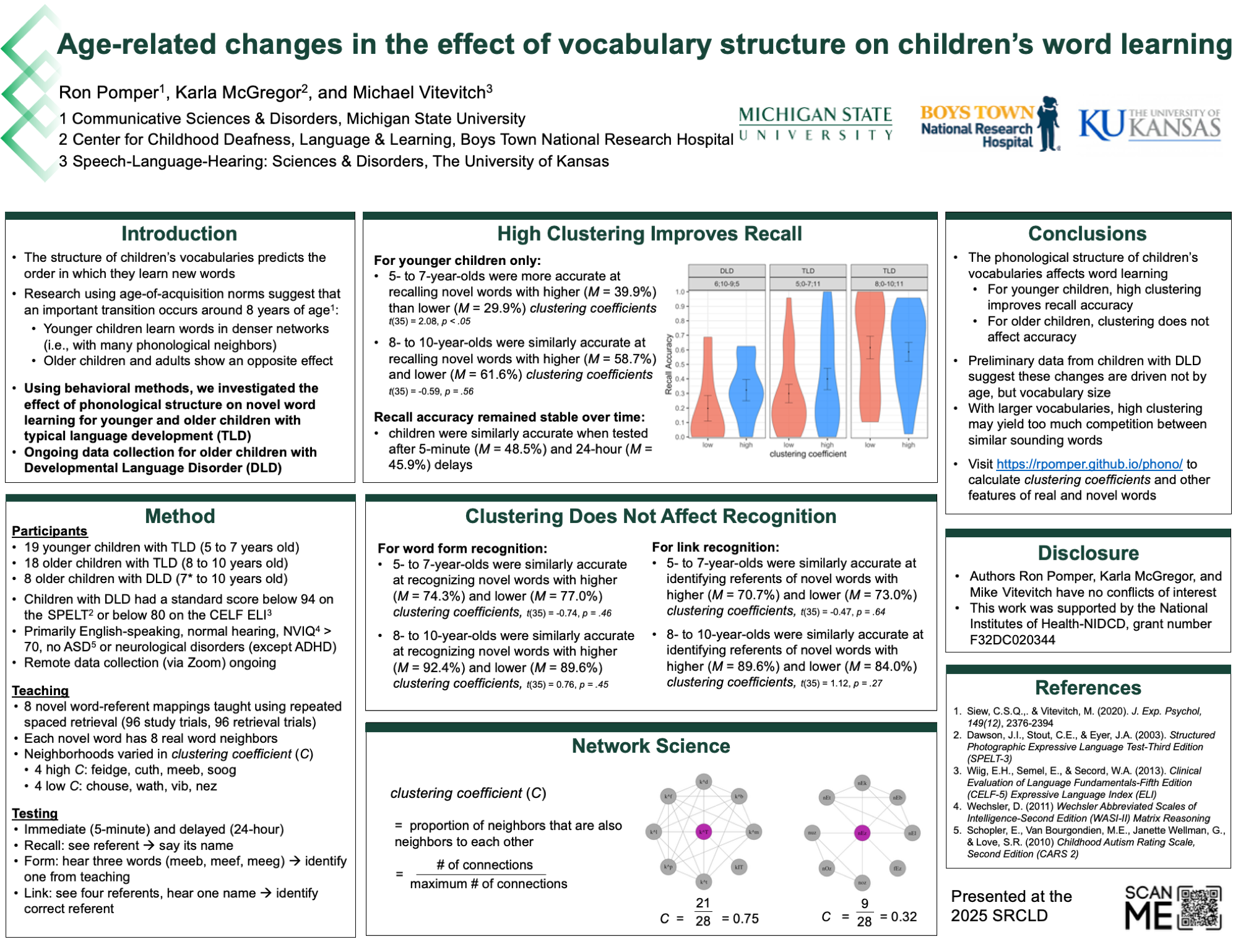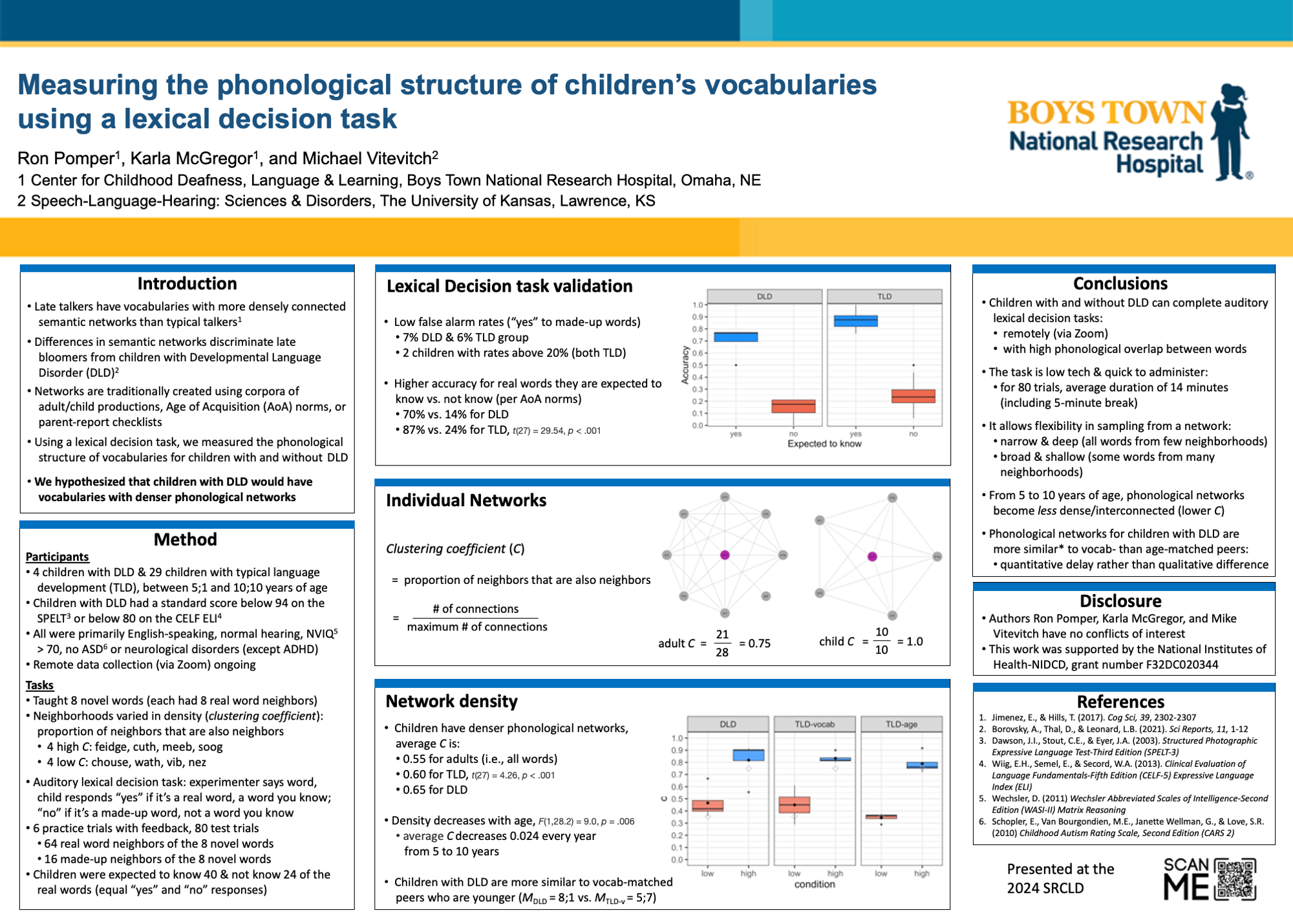PhonoNet
Phonological Networks and Novel Word Learning by Children with Developmental Language Disorder
This project is funded by the NIH. It investigates how the phonological structure of children’s vocabularies affects their ability to learn new words and whether this varies between children with and without Developmental Language Disorder (DLD).
App
We are developing a website to calculate and plot different values for the phonological structure of words (both real and novel). The website will allow you to calculate these features based on the entire English lexicon or a lexicon filtered to include only those words below a certain age of acquisition (e.g., 6 years of age). Additionally, it provides normative data for each phonological feature (e.g., what is the average length in phonemes of words in a 6-year-old’s vocabulary).
The beta version of this website is available here: https://rpomper.github.io/phono/
Note: it will take 1 to 2 minutes for the website to load, because it uses shinylive to run the Shiny application locally rather than hosting it on an external server.
SRCLD 2025
We presented this research at the 2025 Symposium on Research in Child Language Disorders:

Citation: Pomper, R., McGregor, K. K., & Vitevitch, M. S. (2025, May). Age-related changes in the effect of vocabulary structure on children’s word learning. Poster presented at the Symposium for Research on Child Language Disorders, Madison, WI.
SRCLD 2024
We presented this research at the 2024 Symposium on Research in Child Language Disorders:

Citation: Pomper, R., McGregor, K. K., & Vitevitch, M. S. (2024, May). Measuring phonological structure of children’s vocabularies using a lexical decision task. Poster presented at the Symposium for Research on Child Language Disorders, Madison, WI.
What we did
Children with Developmental Language Disorder (DLD) struggle to learn new words. They require more exposures to learn novel word-referent pairings than their peers with typical language development (Kan & Windsor, 2010). This problem persists into adulthood and is especially pronounced in their ability to learn the forms of novel words (McGregor, Arbisi-Kelm, Eden, & Oleson, 2020; Pomper, McGregor, Arbisi-Kelm, Eden, & Ohlmann, 2022).
This project investigates how knowledge of other words in English affects children’s ability to learn new words. The central hypothesis is that the phonological structure of children’s vocabularies affects their success in learning new words. In this project, phonological structure is quantified using clustering coefficients, C, which is a metric from network science that measures levels of interconnectivity within different regions of the network.
C quantifies the extent to which phonological neighbors of a target word (i.e., words that differ only by the addition, subtraction, or substitution of a single phoneme) are also phonological neighbors of each other. For a word with high C, many of its neighbors are also neighbors (i.e., high interconnectivity). For a word with low C, few of its neighbors are also neighbors (i.e., low interconnectivity). Prior research has demonstrated a strong effect of C on word learning for adults with typical language development when tested after a delay (Goldstein & Vitevitch, 2014).
We taught 5- to 10-year-old children with and without DLD novel words. Each of the novel words had 8 real word neighbors and children were expected to know at least half (based on age of acquisition norms). Four of the novel words had high C : feidge (fYJ), cuth (k^T), meeb (mib), soog (sug). Four of the novel words had low C : chouse (CWs), wath (w@T), vib (vIb), nez (nEz).
We tested children's success in learning the new words after a 5-minute and 24-hour delay. Tests included recall (see referent, prompted to provide word), form recognition (hear word and two foils, prompted to click on dot for correct word), and link recognition (see four referents, hear one word, prompted to click on correct referent).
We then tested children's knowledge of all of the real word neighbors using an auditory lexical decision task. Children heard words and were instructed to respond "yes" to real words (words that you know) or "no" to made-up words (words that you do not know).
What we learned
Data collection is ongoing. Children are successfully completing the auditory lexical decision task. They have low false alarm rates (responding "yes" to made-up words) and significantly higher accuracy for real words they are expected to know vs. not know (according to age of acquisition norms). This is encouraging, because the task is low tech (verbally administered over Zoom) and involves trials with high phonological overlap (many of the real word and made-up neighbors are also neighbors of each other). The task is relatively quick to administer with an average duration of 14 minutes for 80 trials (including an optional 5-minute break halfway).
Prior research has investigated the semantic structure of children's vocabulary using broad, but shallow sampling techniques (i.e., corpora of child productions or parent-report checklists). A lexical decision task allows greater flexibility. It can be used to collect broad, but shallow samples. Here we collected deep (testing every word in a neighborhood), but narrow (from only a few neighborhoods) samples.
Using this data we are able to calculate individual C values for each neighborhood for each child. We find that the phonological structure of children's vocabularies is denser (i.e., higher average C) than adults. This density decreases with age.